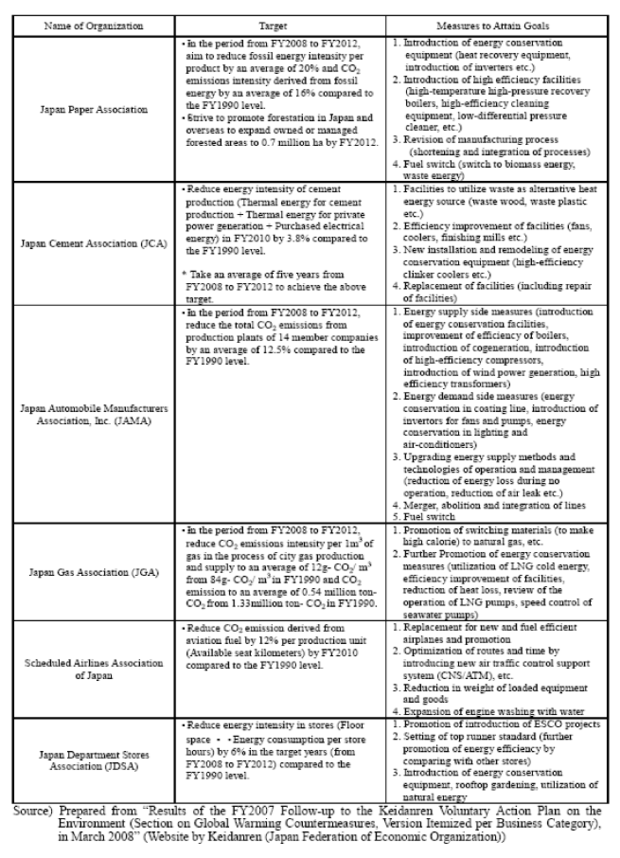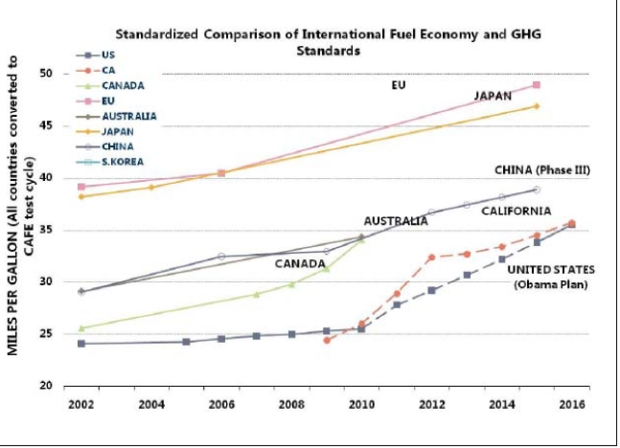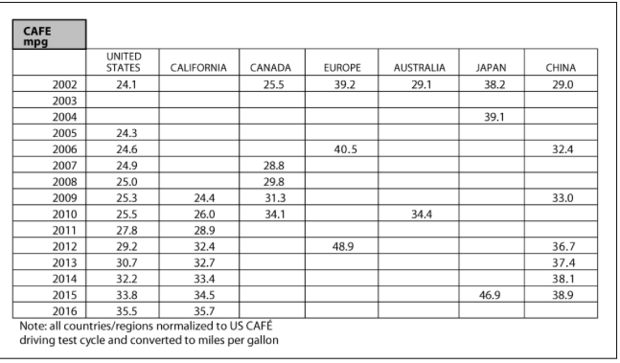Greenhouse Gas Control Policies in Japan
Contents
Overall GHG emission target and timing
[1]Under the Kyoto Protocol, Japan agreed to reduce its GHG emissions to 6% below 1990 levels in the period 2008-2012.
In mid-2008, then-Prime Minister Fukuda offered to reduce Japan’s GHG by 80% from 2008 levels by 2050, and by 8% below 1990 levels by 2020 (without using international credits). Newly elected Prime Minister Yukio Hatoyama pledged Japan to a GHG target of 25% below 1990 levels by 2020, conditional on all major countries’ participation in a new international accord. (The outgoing government’s proposed target was equivalent to 8% below 1990 levels. In 2008, Japan’s GHG emissions were almost 16% above its Kyoto Protocol target.)
Principal Policy Instruments
The Japanese Government formulated in 2005 the Kyoto Protocol Target Achievement Plan (KPTAP) to promote measures to cope with global warming. The KPTAP lays out estimated emissions and expected reductions by sector, and for several specific programs, in order for Japan to meet its Kyoto Protocol target. The 2008 review and revision of the plan called for further actions to close the gap between expected emissions and the Kyoto target, including more stringent efficiency standards for equipment, vehicles, and small businesses. The government plan concluded that it would be very difficult to constrain emission reductions associated with the residential and commercial sectors, and therefore relied on expanding the Voluntary Action Plans in the business sector to achieve 80% of the envisaged further GHG reductions.[2] (See section on covered gases and sectors, below.)
Since October 2008, Japan has established an integrated domestic GHG emissions market, comprised of four components:
(1) Japan’s Voluntary Emission Trading System (J-VETS) capand- trade system, initiated in 2005 for voluntary trading of CO2 emissions from energy and process emissions covering only industries that do NOT have in place a Voluntary Action Program;
(2) an Experimental Japanese Emissions Trading System, with emissions targets based on industry-specific Voluntary Action Programs;
(3) Domestic Credit Scheme, to allow GHG reduction credits (i.e., “offsets”) from small and medium-sized companies; and
(4) Kyoto Credits, available through any of the three Kyoto Protocol emissions trading mechanisms.
The new Hatoyama government has indicated it plans to create a mandatory GHG cap-and-trade system, require “feed-in” tariffs as financial incentives for renewable energy generation, and may consider a carbon tax.[3] The Hatoyama campaign, on the other hand, pledged before the election to eliminate highway tolls and a fuel tax of about 25 yen (US$0.28)[4] per liter on gasoline by April 2010, which could raise vehicle GHG emissions by as much as 20%.[5] The Law Concerning the Promotion of Measures to Cope with Global Warming[6] enacted in 1998, directed the national government to promote GHG emission reductions and to enhance carbon sinks. It also directed local governments and business to take actions to limit emissions. This basic authority also directs the central government to publish Japan’s GHG emissions. The 5,000 largest businesses in Japan have been required to report their energy production and consumption for more than a decade by the Law Concerning the Rational Use of Energy.[7] Consequently, the foundation for calculating the energy-related CO2 emissions from each industrial source is established.
The Act on Promotion of Global Warming Countermeasures and Act on Rational Use of Energy establish authorities to promote energy efficiency in “energy-using” equipment, buildings, factories, and machinery. These and related legislation require efficiency labeling, and allow for low-interest financing, industrial improvement bonds, tax exemptions and other financial incentives to promote efficiency. They also require efficiency measures by industrial facilities and for appliances. The Energy Conservation Center of Japan (ECCJ) is a public-private partnership for research and implementation of energy conservation programs (including Japan’s Energy Star program, modeled after the US EPA’s), accreditation of energy managers, and information.
Covered Gases and Sectors
Under Japan’s Kyoto Protocol Target Achievement Plan, industry is expected to reduce its GHG emissions to 7% below 1990 levels during the Kyoto first commitment period (2008-2012). The Keidanren Voluntary Action Plan[8] on the Environment (VAP) covers 35 industries, include energy, mining, construction, and at least some manufacturing sectors (e.g. production of vehicles, electronics, steel, cement, etc.)
Allocation of GHG reductions to various sectors
The Keidanren VAPs include a non-binding target of reducing CO2 emissions in industry and energy-converting sectors “below” their 1990 levels by 2010. In the Keidanren VAPs, different industries’ metrics of performance and targets differ. In 2007, about 18 industries tightened their voluntary targets, although some observers have criticized even the more stringent targets as being no more than what was already being accomplished. Others argue that the voluntary targets are costly compared to reductions expected in other countries, such as within the European Union.
Regulations or exemptions specific to trade-sensitive sectors
(See Figure 1 below.)
Motor Vehicles: The Japanese government provides tax benefits for “eco-friendly” vehicles and exemptions from taxes for three years for “next-generation” vehicles.[9] Beginning in April 2009, subsidies have been offered to purchasers of eco-friendly vehicles (e.g., for cars: 100,000 yen, or US$1100). These include a “cash-for-clunkers”-type program that offers higher subsidies to owners who scrap vehicles 13 years or older and replace them with eco-friendly vehicles (e.g., for cars: 250,000 yen, or US$2700). The subsidies extend as well to minivans, trucks and buses. One industry official reported that, with the subsidies, “eco-friendly” vehicles accounted for almost half of vehicle sales in Japan.[10]
Japan is reputed to have among the most stringent fuel economy standards for vehicles in the world, at 46.9 miles per gallon by 2015 (see Appendix). These are expected to constrain new passenger vehicle emissions of GHG. Figure 1. Japanese Regulations or Exemptions Specific to Trade-Sensitive Sectors


(iCET) (2009). Available at http://www.icet.org.cn.

References
Note: The first version of this article was drawn from R40936 An Overview of Greenhouse Gas (GHG) Control Policies in Various Countries by Jane A. Leggett, Richard K. Lattanzio, Carl Ek, and Larry Parker, Congressional Research Service, November 30, 2009.
| Disclaimer: This article is taken wholly from, or contains information that was originally published by, the Congressional Research Service. Topic editors and authors for the Encyclopedia of Earth may have edited its content or added new information. The use of information from the Congressional Research Service should not be construed as support for or endorsement by that organization for any new information added by EoE personnel, or for any editing of the original content. |
Citation
(2012). Greenhouse Gas Control Policies in Japan. Retrieved from http://editors.eol.org/eoearth/wiki/Greenhouse_Gas_Control_Policies_in_Japan- ↑ This section was prepared by Jane A. Leggett, Specialist in Environmental and Energy Policy, Congressional Research Service
- ↑ For a summary of the plan in English, see eneken.ieej.or.jp/data/en/data/pdf/443.pdf.
- ↑ Various press reports, including <a class="external free" href="http://search.japantimes.co.jp/cgi-bin/ed20090925a1.html" rel="nofollow" title="http://search.japantimes.co.jp/cgi-bin/ed20090925a1.html">http://search.japantimes.co.jp/cgi-bin/ed20090925a1.html</a>.
- ↑ Live market currency exchange rate for November 19, 2009 is listed as 1 JPY = 0.0112 USD (<a class="external free" href="http://www.xe.com/" rel="nofollow" title="http://www.xe.com/">http://www.xe.com/</a>). Currency rates are subject to fluctuation.
- ↑ <a class="external free" href="http://www.planetark.com/enviro-news/item/54691" rel="nofollow" title="http://www.planetark.com/enviro-news/item/54691">http://www.planetark.com/enviro-news/item/54691</a>.
- ↑ Law No.117 of 1998.
- ↑ 22 June 1979, Law No. 49. Revised in 10 December 1983, 31 March 1993, 12 November 1993, 9 April 1997, and 5 June 1998.
- ↑ Established by Nippon Keidanren, the Japan Business Federation. Negotiated environmental agreements in Japan have been used in lieu of legally binding regulation since the 1990s, and are not comparable to “voluntary programs” in the United States or some other countries. For example, they may require inspections and there are few reported instances of non-compliance with set targets (Imura Hidefuri, “Building a Cooperative Relationship Between Industry and Regulatory Authorities,” presented at OECD, Environmental Compliance Assurance: Trends and Good Practices Paris, 17-18 November 2008.”
- ↑ <a class="external free" href="http://www.jama-english.jp/asia/news/2009/vol36/index.html" rel="nofollow" title="http://www.jama-english.jp/asia/news/2009/vol36/index.html">http://www.jama-english.jp/asia/news/2009/vol36/index.html</a>.
- ↑ Ibid.
